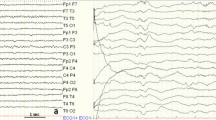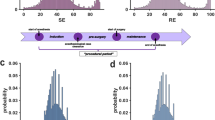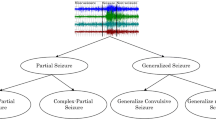Summary
The interval electroencephalograms of 104 patients suffering from simple migraine were analyzed with regard to their background activity and additional pathological waves, and were grouped according to different clinical data.
Diffuse and local dysrhythmic activities were found in 72% of the EEGs. They represent an intermediate state between the normal and epileptic formation of cerebral electric activity and were mainly intensified by hyperventilation, but not so by photic stimulation.
8.6% of the cases displayed sharp waves. Local theta waves were found in 4.8%, most of them in older patients, indicating that they do not seem to be typical of patients with simple migraine.
The additional clinical symptoms such as scintillating scotoma, fainting fits, psychic disturbances or postictal sleep represent temporary accentuations of a neuronal disturbance which is correlated to alterations of respective enzyme patterns or to the combination of transmitters in corresponding neuronal systems rather than to impaired vascular regions.
It may therefore be suggested that dysrhythmic activity, as it is indicating an augmented cerebral excitability, represents a metabolic disturbance of different neuronal systems with temporary exacerbations affecting one or the other system and thus provoking clinical symptoms.
Zusammenfassung
Die Intervall-EEGs von 104 Patienten mit einfacher Migräne wurden bezüglich Grundaktivität und zusätzlicher pathologischer Schwankungen ausgewertet und je nach den klinischen Daten verschieden zusammengestellt.
Diffuse und lokale Dysrhythmien fanden sich zusammen bei 72% des Kurvengutes. Sie stellen Übergangsstadien zwischen normaler und epileptischer hirnelektrischer Aktivitätsgestaltung dar und ließen sich mehrheitlich durch Hyperventilation, nicht aber durch Photostimulation provozieren.
Die klinischen Symptome wie Augenflimmern, Ohnmachten, psychische Begleitsymptome oder postiktaler Schlaf sprechen für temporäre Störungsschwerpunkte innerhalb neuronaler Systeme, die sich nicht mit vasculären Versorgungseinheiten decken, wohl aber hinsichtlich ihrer Enzymgarnitur und Transmitterkombination charakteristische metabolische Einheiten darstellen.
Es liegt daher die Vermutung nahe, daß der Dysrhythmie als Ausdruck erhöhter Erregbarkeit eine metabolische Störung in verschiedenen Neuronensystemen zugrunde liegt, die sich temporär im einen oder anderen System krisenhaft intensivieren kann.
Similar content being viewed by others
Literatur
Bärtschi, W.: Migräne und Epilepsie. Schweiz. med. Wschr. 84, Beiheft zu Nr. 2, 51–53 (1954).
Barolin, G. S.: Migraines and epilepsies — a relationship? Epilepsia (Amst.) 7, 53–66 (1966).
— Migräne. Wien: Facultas 1969.
— Kugler, H.: Fit patterns without characteristic attacks. Electroenceph. clin. Neurophysiol. 13, 658 (1961).
Basser, L. S.: The relation of migraine and epilepsy. Brain 92, 285–300 (1969).
Bille, B.: Migraine in school children. Acta paediat. (Uppsala) 51, Suppl. 136 (1962).
Childs, A. J., Sweetman, M. T.: Study of 104 cases of migraine. Brit. J. industr. Med. 18, 234–236 (1961).
Christian, W.: Klinische Elektroencephalographie. Lehrbuch und Atlas. Stuttgart: Thieme 1968.
Dell, M. B.: Une étude systématique de l'E.E.G. dans l'aviation civile (Comm. personnelle, 1958). Cit. nach Roger, A., Bert, J. Rev. neurol. 101, 334–360 (1959).
Dow, D. J., Whitty, C. W. M.: Electroencephalographic changes in migraine. Lancet 1947 II, 52–54.
Dumermuth, G.: Elektroencephalographie im Kindesalter. Einführung und Atlas. Stuttgart: Thieme 1965.
Engel, G. C., Ferris, E. B., Romano, J.: Focal electroencephalographic changes during the scotomas of migraine. Amer. J. med. Sci. 209, 650–657 (1945).
Gibbs, F. A., Gibbs, E. L., Lennox, W. G.: Electroencephalographic classification of epileptic patients and control subjects. Arch. Neurol. Psychiat. (Chic.) 50, 111–128 (1943).
Gowers, W. R.: The borderland of epilepsy. London: Churchill 1907.
Gschwend, J., Karbowski, K.: Der Normbereich des Alters-Elektroencephalogramms. Schweiz. Arch. Neurol. Neurochir. Psychiat. 106, 269–281 (1970).
Heyck, H., Hess, R.: Vasomotorische Kopfschmerzen als Symptom larvierter Epilepsie. Schweiz. med. Wschr. 85, 573–575 (1955).
Ikonomoff, S. I., Simeonoff, K. R.: Nouvelles conceptions sur l'origine diencéphalique des épistaxis et de la migraine. Observations cliniques. Rev. neurol. 119, 229 (1968).
Jung, R.: Neurophysiologische Untersuchungsmethoden. II. Das Elektroencephalogramm. In: Handbuch der inneren Medizin, Bd. V/1, S. 1216–1325. Berlin-Göttingen-Heidelberg: Springer 1953.
Landolt, H.: Die Temporallappenepilepsie und ihre Psychopathologie. Basel: Karger 1960.
Lennox, W. G.: Science and seizures. New York: Harper 1941.
Matthes, A.: „Maskierte“ und latente Epilepsie im Kindesalter. Dtsch. Z. Nervenheilk. 179, 506–526 (1958).
Molina, A. F. de, Hunsperger, R. W.: Organization of the subcortical system governing defence and flight reactions in the cat. J. Physiol. (Lond.) 160, 200–213 (1962).
Neuendörfer, B., Hoyer, S., Oesterreich, K.: Probleme und Ergebnisse bei Untersuchungen von Elektroencephalogramm, Hirndurchblutung und Hirnstoffwechsel. Arch. Psychiat. Nervenkr. 212, 321–328 (1969).
Niebeling, H. G.: Einführung in die Elektroencephalographie. Leipzig: Barth 1968.
Ninck, B.: Migraine and Epilepsy. Europ. Neurol. 3, 168–178 (1970).
Panzani, R.: Electroencephalographic findings in migraine and bronchial asthma. Int. Arch. Allergy 15, 141 (1959).
— Boyer, R.: Etude électroencéphalographique des migraines. Presse méd. 63, 1211–1214 (1955).
Penfield, W., Jasper, H.: Epilepsy and the functional anatomy of the human brain. London: Churchill 1954.
Robert, F., Karbowski, K.: EEG-Befunde bei Schulkindern. Helv. paediat. Acta 26, 286–299 (1971).
Selby, G., Lance, J. W.: Observation on 55 cases of migraine and allied vascular headache. J. Neurol. Neurosurg. Psychiat. 23, 23–32 (1960).
Segur, G.: La migraine. Etude historique et considérations statistiques. These med., Paris 1959.
Slatter, K. H.: Some clinical and EEG findings in patients with migraine. Brain 91, 85–98 (1968).
Smyth, V. O. G., Winter, A. L.: The EEG in migraine. Electroenceph. clin. Neurophysiol. 16, 194–202 (1964).
Strauss, H., Selinsky, H.: EEG-findings in patients with migrainous syndrome. Trans. Amer. neurol. Ass. 67, 205 (1941).
Ulrich, M.: Beiträge zur Aetiologie und zur klinischen Stellung der Migräne. Mschr. Psychiat. Neurol. 31, 134–203 (1912).
Weil, A. A.: EEG findings in a certain type of psychosomatic headache: Dysrhythmic migraine. Electroenceph. clin. Neurophysiol. 4, 181–186 (1952).
— Observations on “dysrhythmic” migraine. J. nerv. ment. Dis. 134, 277–281 (1962).
Wolff, H. G.: Headache and other head pain, S. 319. New York: Oxford University Press 1963.
Author information
Authors and Affiliations
Rights and permissions
About this article
Cite this article
Gschwend, J. EEG-Befunde und ihre Interpretation bei einfacher Migräne. Z. Neurol. 201, 279–292 (1972). https://doi.org/10.1007/BF00316419
Received:
Issue Date:
DOI: https://doi.org/10.1007/BF00316419




